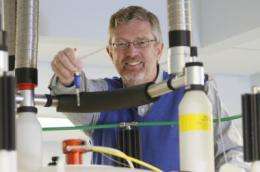Solving the mystery of blood clotting

How and when our blood clots is one of those incredibly complex and important processes in our body that we rarely think about. If your blood doesn't clot and you cut yourself, you could bleed to death, if your blood clots too much, you could be in line for a heart attack or stroke. Dr. Hans Vogel, a professor at the University of Calgary, has thought a lot about blot clotting and recently published research in the Journal of the American Chemical Society that helps to better understand the clotting process.
Vogel and his graduate student Hao Huang were able to determine the molecular 3D structure of a protein in blood platelets and a receptor that sticks through the membrane of the cell to the outside. Platelets are tiny cells specialized for clotting reactions. The receptor protein is unique for platelets and directly controls blood clot formation. Other scientists have unsuccessfully attempted to map this structure, but Huang and Vogel were the first to make it work.
"The goal of the research is to provide a molecular level understanding of the blood clot regulatory process," says Vogel, of the Department of Biological Sciences in the Faculty of Science. "Eventually the long term goal is to interfere in that, although one has to be extremely careful with such a delicate process. Oftentimes, these molecular structures are useful for pharmaceutical companies and for follow-up research projects that take them as a starting point to develop new drugs."
This particular piece of research is also related to Vogel's lab's larger goal, which is to figure out how our body responds to foreign invasions of bacteria, particularly in relation to superbugs that aren't treatable by antibiotics. "You don't really want to have an infection starting in and around a blood clot," says Vogel. "So once a platelet is lodged into position it releases all sorts of proteins and then it attracts all these factors that are antimicrobial. Platelets get together with white blood cells and together they orchestrate a really important antimicrobial response."
The next step in Vogel's research is to try to find out more about this antimicrobial response and build on it. "A lot of science is putting pieces into a large puzzle," says Vogel. "I've been involved in active research for 30 years. If you look over your career, then you make many incremental steps forward, but everything together builds a big picture. The paper we recently published proved to be a very important piece of the puzzle." Vogel's research in this area is supported by Alberta Innovates Health Solutions and the Canadian Institutes for Health Research.
















